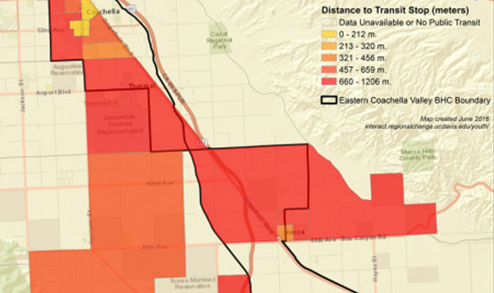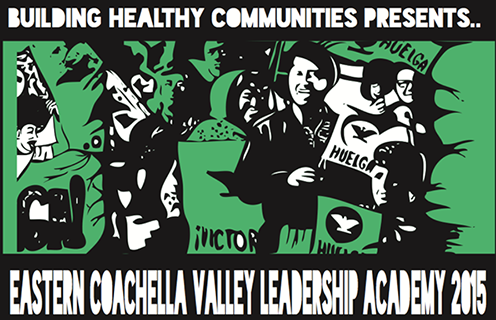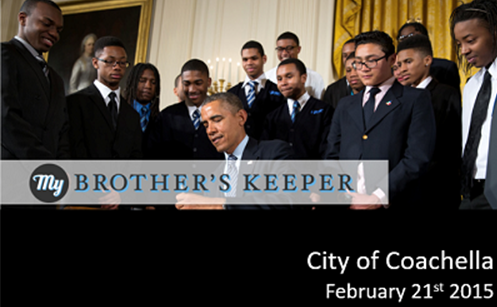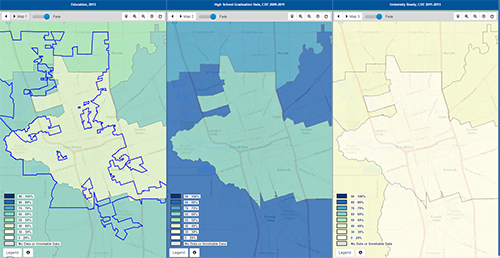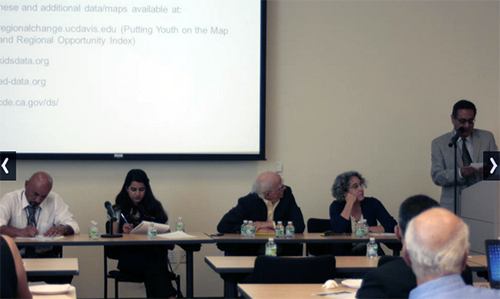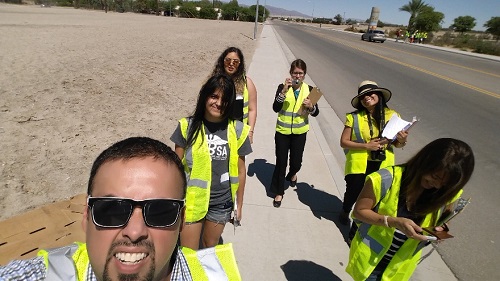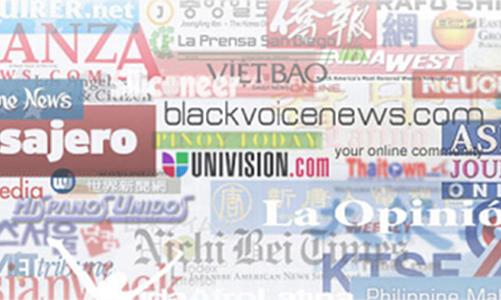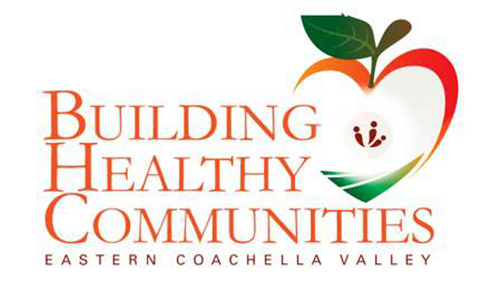Stories
From youth-led skits to reports at the Capitol, PYOM supports diverse efforts by providing accessible, clear, area-specific information. Below are some examples of PYOM at work in partnership with youth, nonprofits, businesses, government agencies, and multi-sector coalitions.
Fighting for Water Justice
Members of Project 4-H2O at John Swett High School in Crockett, CA wondered whether or not their peers had access to clean and safe drinking water. The youth team surveyed their school and in their results identified water access points frequented by students on-and-off campus. They then wanted to create a map to illustrate their findings but before doing so were guided through the PYOM curriculum modules and the PYOM online resources to deepen their knowledge about maps. Most importantly, PYOM helped the youth learn and discover that the use of data through mapping is a powerful research method to enhance advocacy efforts for school and community change. Inspired, the team created their own map of the water access points and identified the water fountains located at each site. The youth team collected water samples for testing to determine water safety, and also evaluated the appeal of the water fountains via a checklist, observations and tastings. Team members presented their research findings at a school board meeting and asked for the board’s continued support to fund new water stations on campus—an environmental change that will ensure every student has access to free, safe and appealing water at school. To learn more, contact Eli Figueroa, UC CalFresh YPAR Project Coordinator for Contra Costa County, at eifigueroa@ucanr.edu.
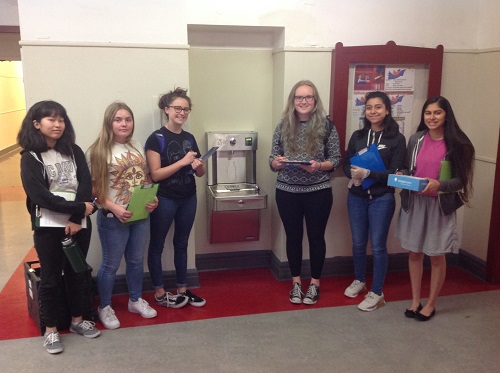
Maps in Youth Media
Part of the Eastern Coachella Valley's new youth media hub, Coachella Unincorporated, (supported by coordinator Amber Amaya and New American Media), has been working to include data and mapping that can support youth generated articles. In this effort, youth reporters from Coachella Unincorporated have written and published their first hard copy publication called Miles Away. In the supporting online article, Coachella Unincorporated used youth transit maps from PYOM to complement youth-generated research on the issue of transit access in the Eastern Coachella Valley. The CRC is proud to support this work and looks forward to more youth-generated media that speak to their experience, use data and maps, and help advocate for needed community changes.
Identifying Shared Local Youth Issues
Last year, high school youth with the Eastern Coachella Valley’s Building Healthy Communities initiative used PYOM to explore issues in their area. Youth looked at data maps related to their personal/peers’ concerns: access to transportation, access to healthcare facilities, and well-being in schools. The maps helped them assess whether challenges they and their peers were experiencing were also broader community challenges. This helped them direct their advocacy efforts and also supported their arguments for needed changes. To learn more contact Mr. Victor Gonzalez, ECBHC Civic Engagement Manager and Youth Coordinator, at vgonzalezbhc@gmail.com.
Informing Community Action to Support Boys and Young Men of Color
Young people used PYOM and the Regional Opportunity Index (ROI) to support the City of Coachella’s acceptance of the My Brother’s Keeper challenge (www.whitehouse.gov/my-brothers-keeper). They used the website to create a PowerPoint presentation for the community, sharing visual, easy to understand information on topics like access to economic opportunities, school suspension rates, and racial/ethnic and gender disparities in high school graduation rates. After breaking up the audience into topically focused groups, they also went online to further dig into relevant data that could inform action planning. To learn more contact Mr. Victor Gonzalez, ECBHC Civic Engagement Manager and Youth Coordinator, at vgonzalezbhc@gmail.com.
Engaging Local Government
Eastern Coachella Valley youth in the BHC Youth Organizing Council and adult leaders recently took on Soapbox Speeches — short presentations to judges from local government on opportunities for community improvement. As part of their preparation, young people used PYOM maps to help connect their personal experiences with broader local patterns. With this strong foundation, these youth are now preparing to participate in discussions and meetings with decision-makers. To learn more contact Mr. Victor Gonzalez, ECBHC Civic Engagement Manager and Youth Coordinator, at vgonzalezbhc@gmail.com.
Monitoring Community Action to Promote Equity
The San Joaquin County Alliance of Boys and Men of Color worked with the UC Davis Center for Regional Change to report analyses of child and youth well-being in Stockton, CA. This report will support the local response to the White House My Brother’s Keeper initiative. In particular, these analyses provide context for local planning and a baseline for monitoring community progress on the initiative’s six milestones. The report includes maps from Putting Youth on the Map (PYOM) and the Regional Opportunity Index (ROI), as well as data available via PYOM links. This report was represented at the White House by Mr. Samuel Nunez, an Alliance leader and the Executive Director of Fathers and Families of San Joaquin. Stockton youth and adult leaders then came together to launch the report and associated action locally. To learn more about the work of the Alliance and the report see Fathers and Families of San Joaquin at ffsj.org or contact Mr. Jagada Chambers at jchambers@ffsj.org. Read the report here.
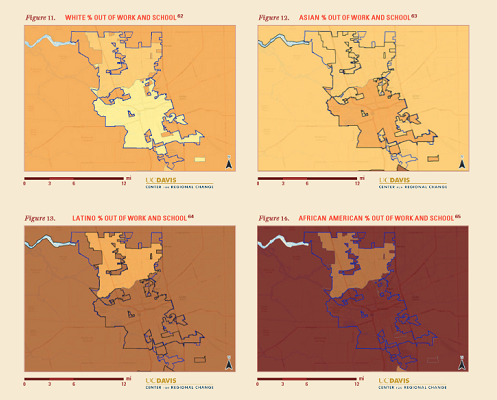
Facilitating Youth Voice
Sacramento youth from Building Healthy Communities and from Asian Resources brought community challenges to life through skits based on PYOM data. After learning from the maps of their city, the youth interpreted the information and focused on three key areas: safety, education, and employment. They then developed and recorded skits which were unveiled at the 2015 Sacramento My Brother’s Keeper Summit to elected officials and youth. The skits communicated the information and its impacts on daily life to an intergenerational audience in a powerful way. As a result, other youth at the summit were encouraged to speak up and share their experiences as well.
Promoting Courageous Conversation
Yolo County Superintendent of Education Dr. Jesse Ortiz saw a need for cross-sector planning and action to address disparities associated with race/ethnicity and SES in children’s learning outcomes. In response, he initiated an Education and Equity Summit Speaker Series, which launched with a map-based presentation on Educational Status of Children in Yolo County. Dr. Nancy Erbstein, presenter and Putting Youth on the Map project director, supported these panelist presentations alongside a community day school principal, a long-time state and county educational policy leader, and a current UCD student who graduated from Woodland High School. Over 50 people attended, reflecting a wide variety of stakeholders such as K-12 school districts, school boards, public health, housing, youth development, probation, and county and local government.
Bringing Youth Perspectives to Land Use Planning
Mr. Miguel Vazquez, a planner at the Riverside Co Department of Public Health, engaged youth to inform General Plan Development through Land Use Planning Awareness LUPA. Youth have used PYOM and ROI resources to inform their own walk audit research, and they will combine this information with their own analyses as they participate in local planning. To learn more about LUPA go to dophlupa.weebly.com.
Communicating Diverse Communities’ Experiences
Media’s role in reflecting and shaping public interest is an important aspect of policy-making. These mapping tools have been identified as powerful resources for young journalists. New American Media is the first and largest national collaboration and advocate of 3,000 ethnic news organizations. In response to a request from them, CRC Community Engagement Coordinator Mr. Sergio Cuellar oriented to PYOM California staff who support young journalists to produce media about conditions in their communities for multiple platforms. In light of interest within youth journalism networks, we are also training youth media teams from 14 California communities associated with TCE’s Building Healthy Communities initiative. We’re curious to see how these journalists make use of these analyses across multiple media platforms.
Connecting Personal Experiences with Regional Challenges
In 2014, Sacramento youth leaders dedicated an August summer day to learning how to create, analyze, and use PYOM map data. A team of youth from South Sacramento’s Building Healthy Communities worked with the UC Davis Center for Regional Change to help pilot the PYOM website by exploring food deserts in their community. Connecting local map data with their own experiences, these youth participants better understood the personal and far-reaching consequences of food deserts. Click here for a story and video about their experiences, courtesy of AccessLocal.TV.
Empowering Youth to Promote Youth Engagement
Youth from Building Healthy Communities, Eastern Coachella Valley division, participated in a PYOM pilot workshop in October 2014. Participants were divided into two action teams: “Neighborhoods, Prevention & Schools” and “Boards & Commissions.” In this workshop, youth participants learned about the power of data mapping, the content and functions of PYOM, and how to use data and digital maps as part of their local change work. Youth from the action teams then presented what they learned to their teams’ adult allies in addition to a proposal to increase the role that the youth play these teams, putting their knowledge of data and mapping to use.

